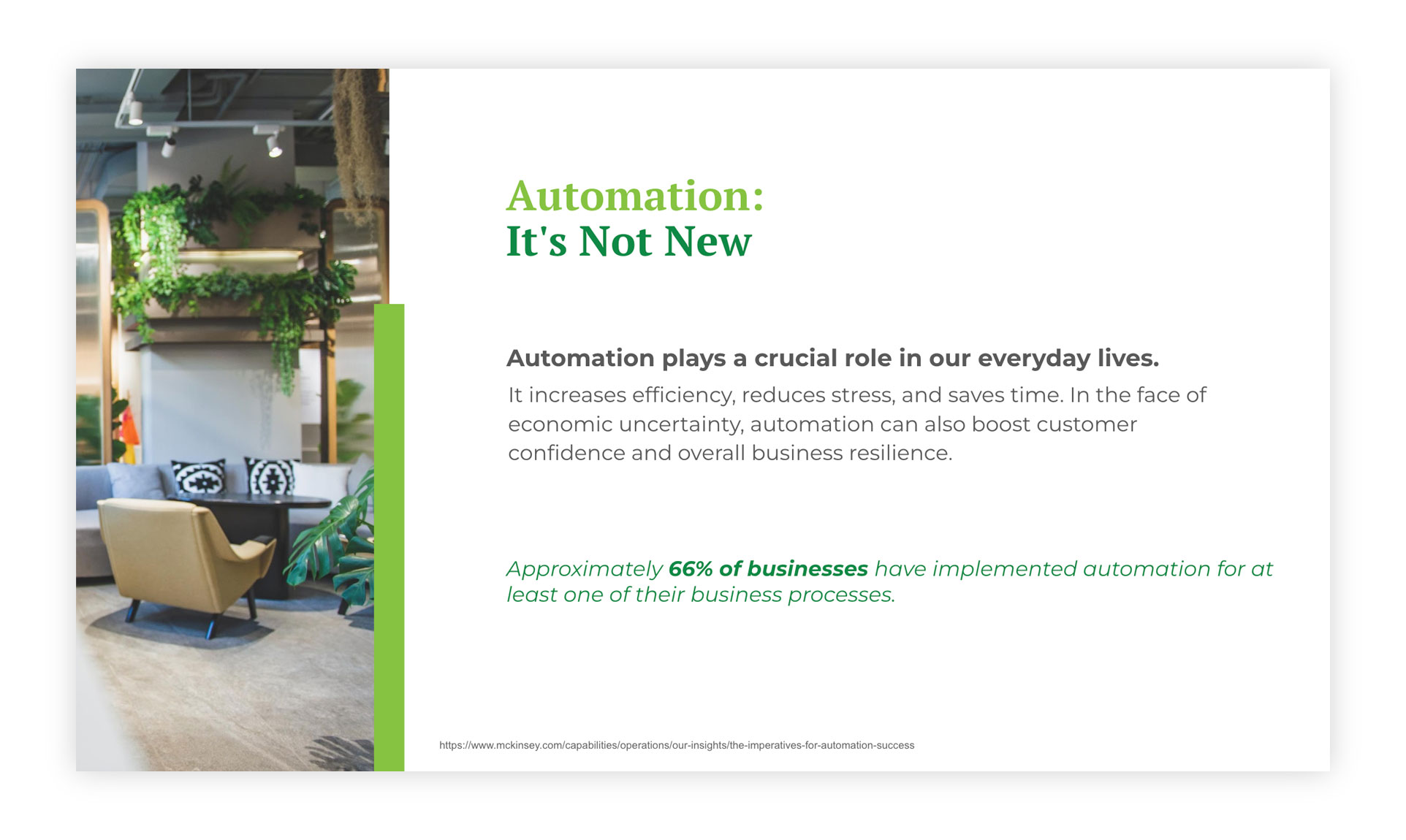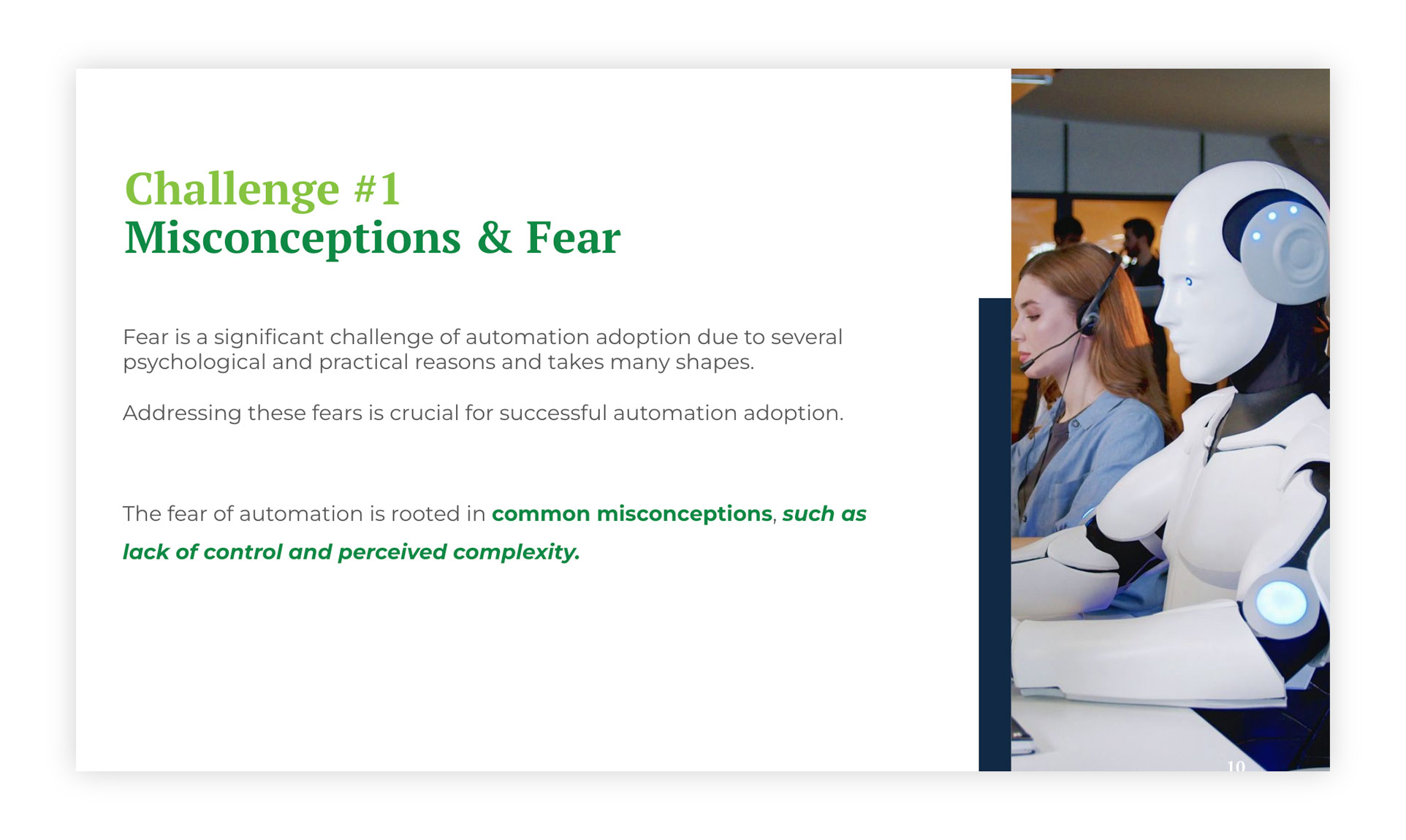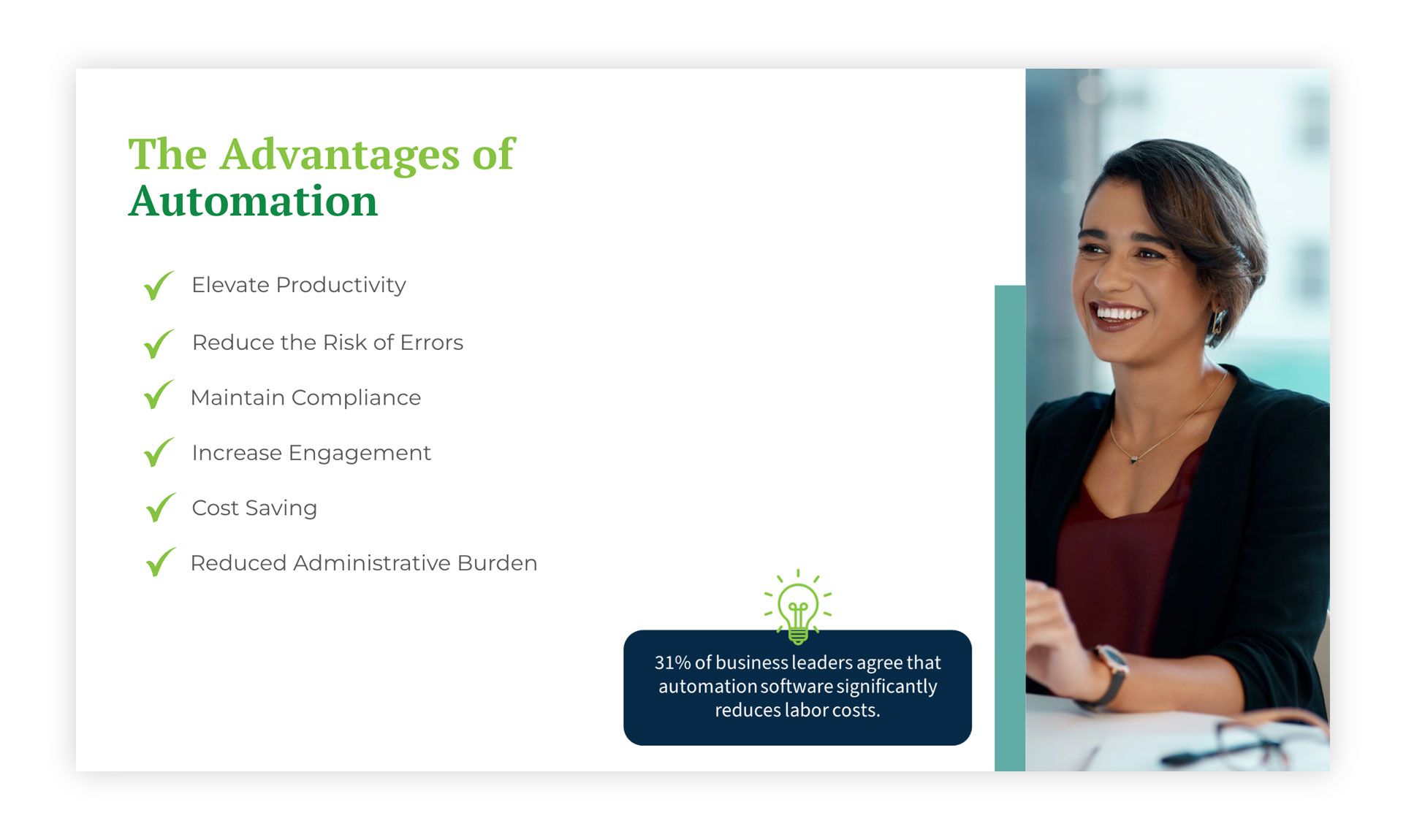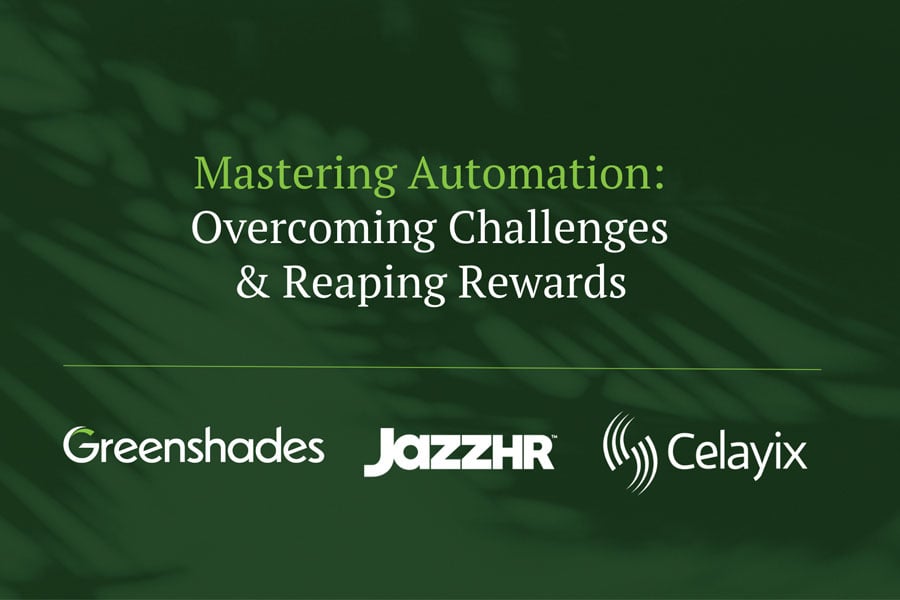Introduction
Welcome to this comprehensive recap of our recent webinar, where we discuss the transformative power of automation in HR, workforce management, and payroll functions. Our panel of experts includes Scott Lowdermilk, Josh Jones, and Gurmit Dhaliwal.

Watch the On-Demand Webinar here:
Automation is not new
As our panelists explain automation is not a novel concept. It has been steadily shaping the business landscape for years, optimizing processes, improving productivity, and revolutionizing industries across the board. However, the recent surge in technological advancements and the increasing complexity of business operations have heightened the importance of automation, making it a pivotal strategy for companies striving to stay competitive and efficient.

The Impact of Automation on HR, Workforce, and Payroll
Automation offers multifaceted advantages for HR, workforce, and payroll functions. The recruitment process has greatly benefited from automation. Technology-driven platforms empower recruiters to efficiently source and assess candidates, minimizing manual effort and reducing the time-to-hire significantly. This transformative approach not only accelerates the hiring process but also enhances the quality of hires by leveraging AI-driven insights to match candidates' skillsets with job requirements.
With tools like self-scheduling interviewing, the once labor-intensive task of coordinating interviews has become remarkably efficient. Candidates can now seamlessly choose interview slots, eliminating the back-and-forth communication and enhancing the overall candidate experience. The profound impact of this streamlined process is evident in Josh's anecdote of scheduling nine interviews on his fourth day on the job—a task that would have been inconceivable without automation.
Efficiency and Transparency: The Core of Automation's Rewards
The tangible rewards that automation brings to businesses extend beyond process optimization; it influences company culture, scalability, employee satisfaction, and even retention rates. By centralizing information and fostering transparency, automation nurtures a sense of trust and openness within the organization. This cultural shift enhances employee morale, making them more engaged and loyal.
Employee apps, real-time communication platforms, and self-scheduling tools empower employees to actively participate in scheduling and decision-making processes. This not only increases efficiency but also empowers employees, ultimately contributing to higher retention rates.
Navigating Challenges: Remote Work and Diversity
As businesses adapt to the realities of remote work, the question of digitalizing the workforce, even in remote areas, arises. The panelists address this challenge, emphasizing that automation solutions are designed to cater to a distributed workforce. Cloud-based systems, mobile apps, and internet connectivity enable seamless remote workforce management, ensuring that employees can access vital HR and payroll functions regardless of their location.
Diversity and inclusion also take center stage as Josh Jones highlights the role of automation in recruiting and incentivizing diverse candidates. He stresses the importance of strategic outreach and targeting specific candidate pools through technology-driven platforms. This approach facilitates the recruitment of diverse talent and promotes inclusivity within organizations.
The Challenges
Navigating Automation Hurdles
While the benefits of automation are undeniable, the road to implementation is not without its challenges. Our panelists explain the obstacles that businesses might encounter on their journey toward automation and how to overcome them effectively.

Scott Lowdermilk's Insights: Balancing Automation with Personal Touch
There are potential pitfalls of losing personal touch in HR processes due to excessive automation. While technology can enhance efficiency, it's crucial to strike a balance and ensure that the human element is not compromised. Candidate experience and employee engagement remain paramount, and automation should be integrated thoughtfully to complement human interactions rather than replace them entirely.
Josh Jones' Perspective: Ensuring Smooth Implementation
The challenges related to implementing automation successfully can underscore the importance of clear communication and change management strategies when introducing new technology to a workforce. Employees should understand the benefits and purpose of automation to embrace the changes seamlessly.
Gurmit Dhaliwal's Insights: Ensuring Data Accuracy and Security
As businesses rely more on technology-driven solutions, safeguarding sensitive employee data and ensuring data accuracy becomes paramount. Gurmit stresses the significance of partnering with trusted technology providers that prioritize data security and compliance. Organizations must ensure that automation platforms adhere to industry standards and regulations to mitigate potential risks.

Misconceptions & Fear: Unraveling Automation Myths
There are many misconceptions and fears surrounding automation. It is important to shed light on these concerns and provide valuable insights to help organizations make informed decisions about adopting automation.
Scott Lowdermilk's Insights: Overcoming Resistance
Resistance can arise when introducing automation within an organization. Employees may fear job displacement or loss of control, but automation is meant to enhance productivity, not replace human roles. Open and transparent communication about the benefits of automation can help quell these fears and pave the way for a smoother transition.
Josh Jones' Perspective: Navigating Misconceptions
There are misconceptions that businesses might have about automation, such as the assumption that it's complex and requires a significant learning curve. Modern automation solutions are designed with user-friendliness in mind, making them accessible to employees at all levels. Clear demonstrations of how automation simplifies tasks can help dispel these misconceptions and encourage adoption.
Gurmit Dhaliwal's Insights: The Role of Education
Education can be a powerful tool in dispelling automation-related fears. Fear can stem from a lack of understanding about how automation works and its potential impact. By offering training and resources that demystify automation, organizations can empower their workforce to embrace technological advancements rather than fear them.

Technology Integration: Streamlining Workflows Through Automation
Automation can streamline workflows across various business functions and enhance efficiency and collaboration.
Scott Lowdermilk's Insights: Embracing Integration
Integrating different automation tools can create a holistic solution. For instance, the benefits of connecting recruitment platforms with payroll and HR systems, enabling a seamless flow of data from candidate sourcing to employee onboarding. This integration not only reduces manual data entry but also ensures accuracy and consistency in information.
Josh Jones' Perspective: Enhancing Communication
There are several automation tools that facilitate real-time communication, such as employee apps and messaging systems. By providing employees with instant access to schedules, updates, and important information, organizations can foster better collaboration and keep everyone on the same page.
Gurmit Dhaliwal's Insights: Self-Scheduling and Transparency
Automated self-scheduling tools can empowers employees to choose their shifts based on their availability and preferences. He points out that automation tools can offer transparency in shift allocation, allowing employees to have more control over their work schedules. This not only enhances job satisfaction but also reduces scheduling conflicts and grievances.

Adoption: Overcoming Challenges and Embracing Automation
Adoption of implementing automation might seem like a daunting task for organizations. Our expert panelists discuss solutions and how to overcome these challenges; providing their insights on encouraging adoption and maximizing the benefits of automation.
Scott Lowdermilk's Insights: Change Management
Employees might initially resist change due to fear of the unknown or reluctance to adapt, however involving employees in the decision-making process, providing training, and showcasing the positive outcomes of automation eases the transition.
Josh Jones' Perspective: User-Friendly Interfaces
Automation tools that are intuitive and easy to navigate and reduce the learning curve for employees. It is important to offer ongoing support to address any questions or challenges that users might encounter during their interaction with new systems.
Gurmit Dhaliwal's Insights: Customization and Flexibility
Customization and flexibility help ensure successful adoption. Each organization has unique requirements and processes, and automation solutions should be adaptable to accommodate these variations. Tailoring automation tools to match the organization's existing workflows also can make the transition smoother.
The Opportunities & Rewards
There are many opportunities and rewards that automation brings to businesses. Our panelists share their thoughts and ideas on leveraging automation to streamline processes, enhance efficiency, and create a more productive and engaged workforce.

Scott Lowdermilk's Insights: Simplifying Communication and Transparency
Automation can simplify communication within a workforce. The importance of real-time employee apps and other digital tools enables seamless communication between teams, especially in remote and distributed environments.
Josh Jones' Perspective: Efficiencies in Recruitment
The utilization of AI-driven tools for candidate sourcing in recruitment and talent acquisition, along with the automation of initial outreach, can substantially accelerate the interview scheduling process, thereby diminishing the time and effort needed to coordinate interviews
Gurmit Dhaliwal's Insights: Workforce Communication and Empowerment
There are several benefits of automating workforce communication and empowerment. For example, employee self-scheduling, which empowers employees to choose their shifts and schedules, resulting in improved job satisfaction and work-life balance.
As we explore the diverse opportunities and rewards that automation offers, it becomes clear that businesses can achieve enhanced productivity, engaged employees, and improved operational efficiency.
Automate Your Payroll and HR Processes with Greenshades
Are you ready to unlock the full potential of automation? Take the first step towards transforming your business processes. Contact Greenshades today to learn more about how our solutions can propel your organization forward. Our experts are here to guide you through the journey of embracing automation, ensuring a seamless transition and a brighter future for your business.




























